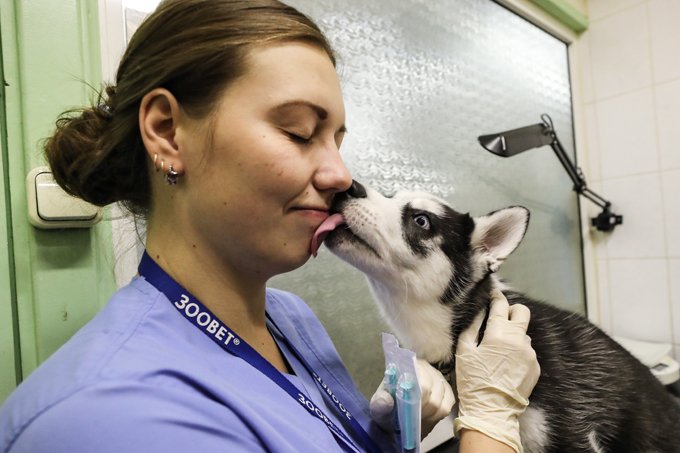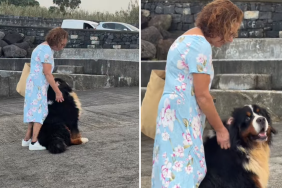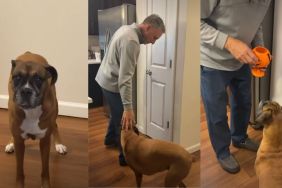DogTime Moderator: Welcome to this PetChat hosted event brought to you by WebVet with Dr. Susan Aiello, DVM. Dr. Susan will answer your questions on dog obesity and what to feed your dogs to keep them healthy. Welcome Dr. Susan!
Dr. Susan: Hello! My name is Susan Aiello, and I received my veterinary degree from Michigan State University in 1984. I practiced small animal medicine in the Midwest, and am the former Editor of The Merck Veterinary Manual. Did you know that nearly 40% of pets are overweight?! Let’s get talking about how to keep YOUR pet from tipping the top of the weight chart.
Moderator: Is there a particular type of dog food that dog owners should stay away from?
Dr. Susan: There isn’t a specific food that’s needed or that you should stay away from. It should be complete and balanced of course, but the key is moderation in both diet and exercise. Staying away from high-fat treats, like table food, will go a long way toward keeping your dog trim.
MaggieC: How can you tell how much your dog should weigh?
Dr. Susan: As far as how much your dog should weigh, it’s a good idea to look at breed standards. Then adjust from there depending on your dog’s age and activity level, etc.
Puppy Feeding
momof3bostons: I adopted a Boston Terrier that gave birth to 7 babies. 5 lived. The puppies will be 4 weeks Saturday. Momma dog has started to wean them already. Can I feed them, and what do I start with?
Dr. Susan: Yes, sounds like the mother dog has already started the weaning process for you! You can feed small amounts of a high-quality canned puppy food, mixed with some water or even a little milk (a little!). Let the pups eat for 10-15 minutes and then take the food away. You can start with one or two puppy food feedings a day and work up as the mother nurses the pups less.
momof3bostons: Should I make her let them nurse?
Dr. Susan: If she won’t allow the pups to nurse at all, then you’ll have to make sure each of the pups is getting enough, which can be tough in a group! You may need to provide some supplemental feeding with a puppy milk replacer. But usually by 5-6 weeks, the pups can be fully weaned.
momof3bostons: Great. I appreciate your time and wonderful advice. You have been very helpful.
Pet Food Labels And Home Cooking
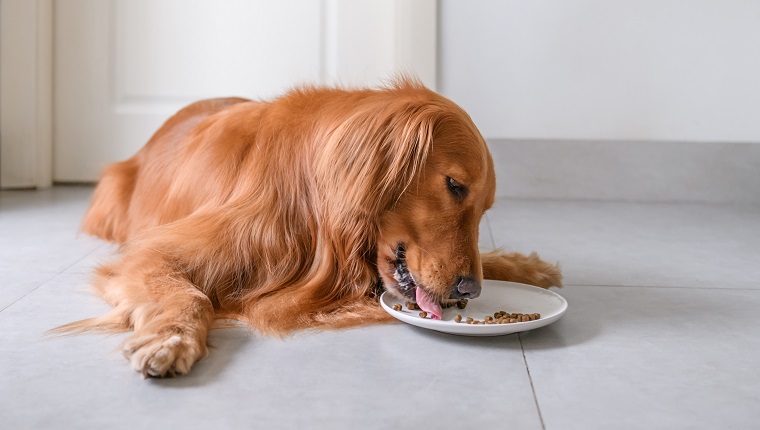
Crazymonkey: What are some examples of high quality canned puppy food?
Dr. Susan: To find good pet foods for any life stage, including puppies, read the label. The key words you want to see are “complete and balanced.” You have even more assurance if the label reads that the food meets “AAFCO standards.” (FYI, The AAFCO is the American Association of Feed Control Officials.)
Crazymonkey: Awesome. So canned food is better than home cooking?
Dr. Susan: Home cooking is an option, but it’s very tough to do correctly. Sometimes it’s difficult to obtain all needed ingredients to ensure that the food is complete and balanced. If you want to home-cook, I’d strongly advise working with a veterinary nutritionist. Commercial canned is a lot easier and brings lots of assurance. With five pups, you should have plenty to do!
Handling Finicky Eaters
MaggieC: Dr. Susan, my friend has a Great Dane and has just opposite problem, the dog is too thin. Any advice on how to get him to eat more?
Crazymonkey: I have a problem with my dog not gaining weight. She’s a finicky eater and that’s why I thought home cooking might boost her appetite. Are there other things I can offer to get some meat on her?
Dr. Susan: Wow, unusual problem for a large/giant breed dog. Does he eat and not gain any weight? Is his appetite low? How much exercise does he get?
MaggieC: His appetite is low. He’s frisky as all get out, but he’s just not interested in food.
Dr. Susan: What is the regular diet of the finicky eater? Dry or canned?
MaggieC: Combo-dried and canned.
Crazymonkey: Some dried food (I have to go through couple of brands to see which one she liked) and some canned food (Beneful).
Dr. Susan: When you feed the dry food, don’t feed it completely dry. Try soaking it with small amounts of water. Also try meal feeding–in other words if the dog doesn’t eat the food in 15-20 minutes, pick it up and put fresh down at the next meal time. You can also try mixing in a small amount of the canned, or some of the “dog gravies” that are on the market. Some dogs also love having a little bit of human baby food mixed on the top!
MaggieC: Baby food! That’s an interesting idea and one I know she hasn’t tried. She’s tried just about everything.
Crazymonkey: Interesting… baby food
Dr. Susan: You can also try heating the food up to room temperature or slightly warm.
Getting Into Shape To Fight Dog Obesity
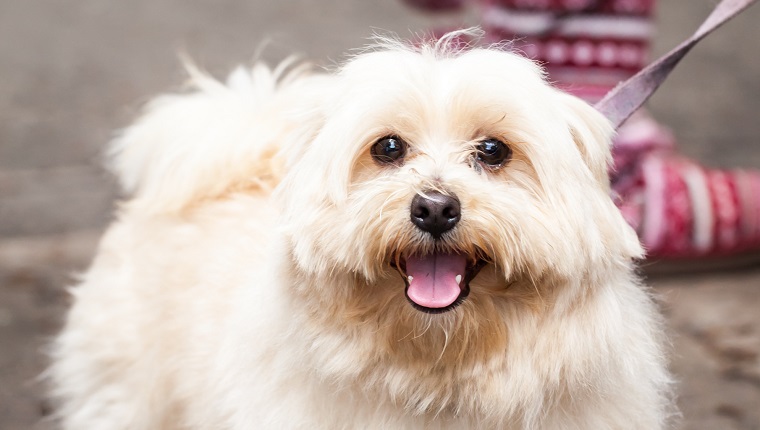
Twinkle: Dr. Susan – here’s my dilemma, I have a 7 & 1 yr old, on dry food. The older one seems to be overweight – Lhasa Apso around 20 lbs. any advice on how I can get her into shape?
Dr. Susan: For Twinkle with the overweight Lhasa, one of the best ways to get an older dog moving and into shape is the all-time favorite dog walk. Start slow, maybe a 10-minute walk twice a day, and then slowly work up to 30 minutes twice a day. If you can get the older dog to play with interactive toys with the younger one, that should help too.
Twinkle: Great! They actually do play a lot and it has made a difference.
Dora: I have a Beagle overweight what should I do?
Dr. Susan: OK, I think Dora is next. Get the Beagle out walking! Beagles also typically are good at ball chasing, so if you have a fenced-in yard or can get to a dog park, try to get her interested in that.
Leg Lameness
Dr. Tubbs: My dog seems to favor her hind right paw. We’ve had x-rays done, inspected it, but can’t find any thing wrong. Any thoughts?
Dr. Susan: For Dr. Tubbs, is the lameness consistent or intermittent?
Dr. Tubbs: Intermittent, seems like only on some surfaces
Dr. Susan: Lameness on any of the other legs?
Dr. Tubbs: Nope, and she doesn’t seem to be in pain. She just favors it sometimes for 10 steps or so.
Dr. Susan: What type of dog and age? One thing to keep in mind is that soft-tissue injuries, like a muscle sprain, are extremely common, won’t show up on x-rays, and can take several months to heal completely.
Dr. Tubbs: Oh boy. She’s about a year old Bull Staffie. Very, very athletic and active.
Dr. Susan: Athletic, muscular dogs are the most prone to muscle injury. I’d keep an eye on it, and if things don’t progress in the right direction, check back with your vet in another 3 weeks or so.
Dr. Tubbs: Will do. Thanks very much for the advice.
Toy Dog Exercise
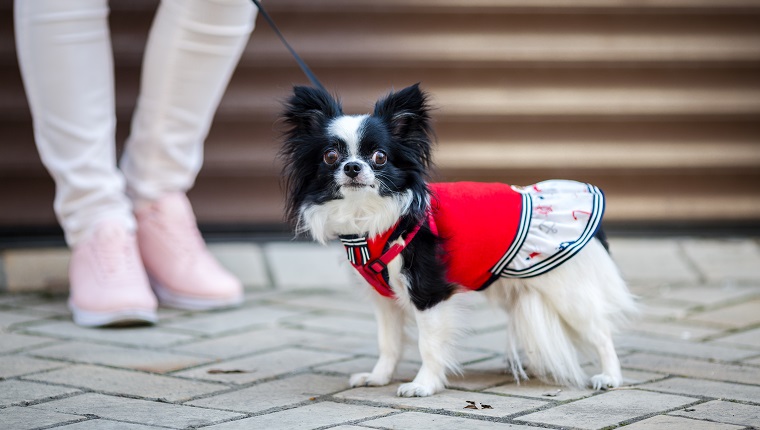
Marmar: My dog is a toy dog and I’m scared she’s not getting enough exercise. How do I know she’s getting enough? She’s a toy Chihuahua. A little over a year. She’s usually indoors and I take her out a few times a week. She just started playing at the dog park
Dr. Susan: For the toy Chihuahua, there are two ways to evaluate your dog’s exercise level. First, think about your dog’s weight. If she’s overweight, she needs either less food or more exercise, or both! If her weight is good, but she seems to have a lot of pent-up energy, then she needs more regular exercise, too.
Marmar: I took her for a jog once around the block. She couldn’t handle it. How much is enough for her?
Dr. Susan: That probably is too much for a Chihuahua. Remember that when you walk at a normal pace, your stride is probably about 4-6 times her little stride. So when you’re walking, she’s already jogging or maybe even running. Walking her around the block is better than jogging, but you may have to go a couple of times a day! Also, remember to go slowly. People don’t go from being couch potatoes to running the Boston marathon without slow and careful training!
Dog Ascites
Chasdick: Hi, good day, is there a particular age a dog can get ascites?
Dr. Susan: I think we had a question on ascites, which is an accumulation of fluid in a body cavity, like the abdomen. It can happen in a dog of any age, but ascites is almost always secondary to another problem, like heart disease, which is far more common in older dogs.
Chasdick: OK thank you
Feeding Dogs Garlic
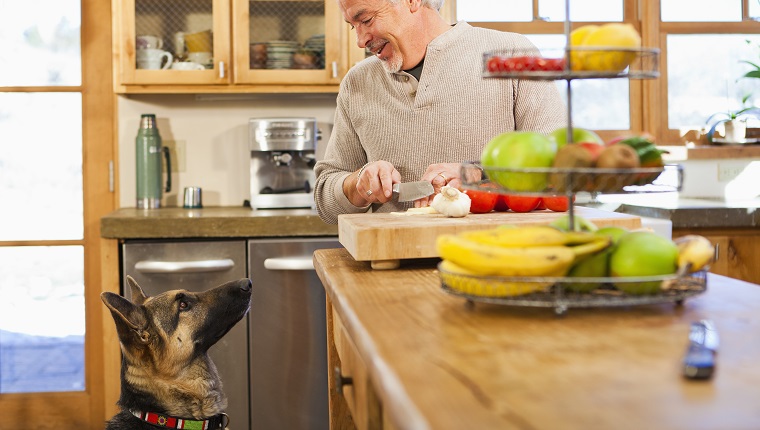
Dr. Tubbs: I’ve heard conflicting reports about garlic. Some say it’s good, some say dangerous. Which is true?
Dr. Susan: For what purpose? Some people say it will help with flea control, but there isn’t good scientific evidence. There’s no purpose for it.
Dr. Tubbs: I’ve just seen it in some dog-treat recipes and wondered if it was ok.
Dr. Susan: Well, let me rephrase that. It’s great on pizza and other Italian goodies, but they’re for people, not dogs!
Dr. Tubbs: Ok, so you recommend steer clear of it if my dogs don’t have flea problems?
Dr. Susan: Ah. Very small amounts are ok, but it isn’t needed. I’d probably leave it out just in case of potential stomach upset.
Dr. Tubbs: Thanks, that’s what I wanted to know.
Dr. Susan: Yes, I’d steer clear of it, even if you had a flea problem. There are far more effective, proven remedies available.
How Much To Feed A Dog
Sanlynnj: I feed my Border Collie, American Eskimo cross Eukanuba, rice and lamb. She gets a lot of exercise–very active. How much, daily, should I feed her?
Dr. Susan: So far, sounds great. Good food and exercise! The proper amount depends on your dog’s age and activity level. The best way to judge is by looking at her body condition. You should be able to easily feel your dog’s ribs, but not see them. Also, when you look at your dog from above, she should have a waistline. From the side, you should see a “tuck” where the abdomen goes into the pelvic area.
Sanlynnj: She is 16 months old; I worry about her not getting enough.
Dr. Susan: If you don’t see a waistline or a “tuck,” then the dog is overweight, and you need to cut down on treats (if she’s getting any) and then on the amount of regular diet. If you can see her ribs, or if her waistline or tuck is prominent, then you can feed a little more.
Sanlynnj: Hard to tell with her fur, but I can feel her ribs. She gets training treats.
Dr. Susan: Well, she’s a young, active dog, and so she may be a little thin. If she’s normal and healthy, you’ll probably see her fill out between age 2 and 3. Remember when you were a teenager? You could drink milkshakes and eat fries and stay thin? The same thing doesn’t happen in your thirties! It sounds like she’s at a good weight, so continue with training treats and let her age a bit. If you see anything abnormal, get her checked out by your vet.
Sanlynnj: She’s getting a cup and a half per day.
Dr. Susan: Sounds about right. Keep up the good work.
Sanlynnj: Thanks.
Warts On Dogs
MaggieC: Are warts on Pit Bulls contagious?
Dr. Susan: If the warts on the pit bulls are papillomas (which is a very common cause), then no, they are not contagious from dog to dog. Papillomas are caused by a virus however, and most of the time, they go away on their own in a few months time.
MaggieC: Ok, thanks!
How Much Water A Dog Should Drink
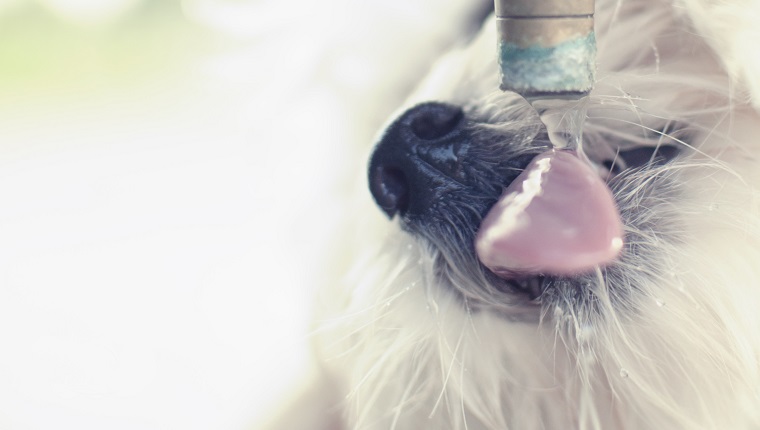
Dr. Tubbs: Is there anything to be worried about if my dog doesn’t seem to drink a lot of water?
Dr. Susan: Probably not. If the dog eats canned or semi-moist food, she’ll drink less water. Water intake also depends a lot on the environment. If it’s cool, she won’t drink as much as in the summer.
Dr. Tubbs: He eats kibble, but it just seems like he goes to the water bowl a lot less than my female.
Dr. Susan: You can keep an eye on him for dehydration. If you can pull up the skin and it doesn’t go right back into place, that’s an easy way to tell if he’s dehydrated. Does the female dog drink a lot? Drinking a LOT of water is much more commonly a sign of disease (eg, diabetes, urinary troubles, endocrine disease, etc).
Dr. Tubbs: Hmm. She seems to drink a normal amount. I’ll try the skin test on my male. Thank you!
Dr. Susan: There’s also individual variability, so keep that in mind, too. If he’s smaller, he’ll naturally drink less.
Hip Dysplasia
todddog1: I fear my dog is developing signs of Hip Dysplasia. Is there anything I should be doing? He is 5 years old.
Dr. Susan: What breed is he? Has he had x-rays?
todddog1: A Collie.
Dr. Susan: First, you want to work with your veterinarian to make sure you have an accurate diagnosis. And Collies certainly do suffer from hip dysplasia. If your dog does have dysplasia, or any other arthritic condition, keeping the weight down is one of the most important things you can do for your dog to be kept comfortable
Moderator: Thank you for participating in our hosted event brought to you by Webvet.com about pet obesity with Dr. Susan Aiello.
